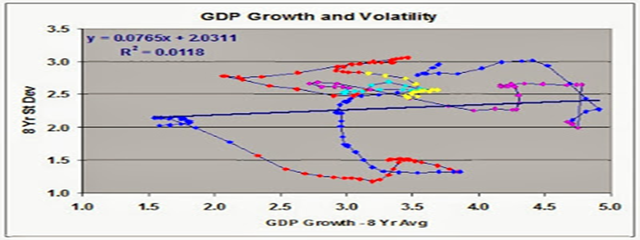 In Part I Jazz Bumpa looks at real growth and concludes:
In Part I Jazz Bumpa looks at real growth and concludes:
The point of all this is to demonstrate that there is more of a difference between the pre- and post 1982 periods than simply a volatility reduction. There is also a decline in RGDP growth, if you dig into the numbers to find it. The Great Moderation really was the Great Stagnation. And it culminated in the Great Recession.
In Part II he looks at volatility and ends:
As I said, I think the Great Moderation is a myth. It’s entire existence is predicated on 2 things: 1) a brief ultra-high volatility blip due to a double dip recession; and 2) completely ignoring the existence of the first little moderation.
But what’s happened since is truly remarkable. We now have what some people consider to be [and applaud as] remarkably stable GDP growth. But what we actually have is the lowest non-recessionary GDP growth ever recorded, coupled with historically high RSD. This is a truly ugly economic environment. Anyone graduating now is the unluckiest of all.
In my view he complicates things. RSD in his last sentence stands for “Relative Standard Deviation”. In statistics lingo that´s the “Coefficient of Variation” (the ratio of the standard deviation to the sample mean – the inverse of the signal/noise ratio). Splicing periods to conform to presidential administrations is not very useful (for example, measures/policies of one administration can have most of their effects on the subsequent one). To top it up I think his charts are very hard to read.
You can read the whole post here.
To visit Marcus Nunes’ blog you can click here.





Be the first to comment on "The “Great Moderation” = the “Great Stagnation”? Not according to ‘phase diagrams’"